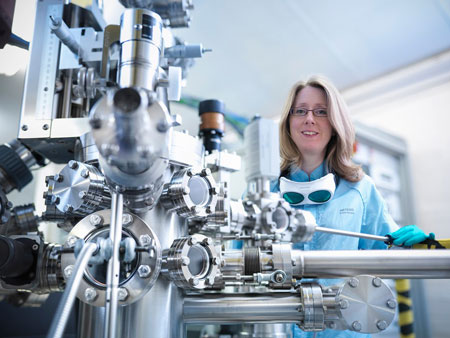| Posted: Aug 06, 2014 |
Future of fast computer chips could be in graphene and not silicon says new research
|
|
(Nanowerk News) Scientists using lasers at a Science and Technology Facilities Council (STFC) facility in the UK believe that they are a step closer to finding a replacement for silicon chips that are faster and use less energy than at present.
|
|
The team has tested the behaviour of bilayer graphene to discover whether or not it could be used as a semiconductor. Their results suggest that it could replace silicon transistors in electronic circuits.
|
 |
| STFC’s Dr Emma Springate, one of the research team, with the Artemis laser.
|
|
Graphene is pure carbon in the form of a very thin, almost transparent sheet, one atom thick. It is known as a ‘miracle material’ because of its remarkable strength and efficiency in conducting heat and electricity.
|
|
In its current form graphene is not suitable for transistors, which are the foundation of all modern electronics. For a transistor to be technologically viable, it must be able to ‘switch off’ so that only a small electric current flows through its gate when in standby state. Graphene does not have a band gap so cannot switch off.
|
|
The research team, led by Professor Philip Hofmann from Aarhus University in Denmark, used a new material – bilayer graphene – in which two layers of graphene are placed one on top of the other, leaving a small band gap to encourage the transfer of energy between layers ("Ultrafast Dynamics of Massive Dirac Fermions in Bilayer Graphene").
|
|
Using Artemis at STFC’s Central Laser Facility, which is based at the Rutherford Appleton Laboratory in Oxfordshire, the researchers fired ultra-short pump laser pulses at the bilayer graphene sample, boosting electrons into the conduction band.
|
|
A second short, extreme ultraviolet, wavelength pulse then ejected electrons from the sample. These were collected and analysed to provide a snapshot of the energies and movement of the electrons.
|
|
“We took a series of these measurements, varying the time delay between the infrared laser pump and extreme ultraviolet probe, and sequenced them into a movie,“ said STFC’s Dr Cephise Cacho, one of the research team. “To see how the fast-moving electrons behave, each frame of the movie has to be separated by just a fraction of a billionth of a second.”
|
|
Professor Hofmann said, “What we’ve shown with this research is that our sample behaves as a semiconductor, and isn’t short-circuited by defects.”
|
|
There can be imperfections in bilayer graphene as the layers sometimes become misaligned.
|
|
The results of this research, in which the graphene showed no defects, suggest that further technological effort should be carried out to minimise imperfections. Once this is done, there is a chance that the switch-off performance of bilayer graphene can be boosted enough to challenge silicon-based devices.
|
|
Graphene transistors could make smaller, faster electronic chips than are achievable with silicon. Eventually more and more transistors could be placed onto a single microchip to produce faster, more powerful processors for use in electronic equipment.
|

